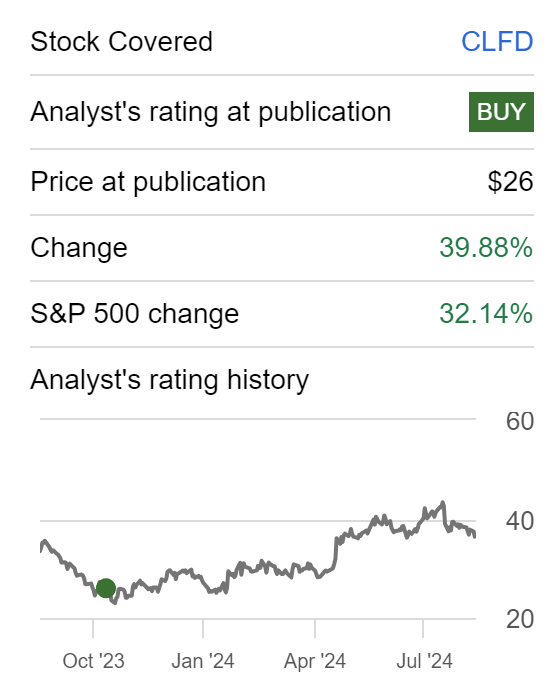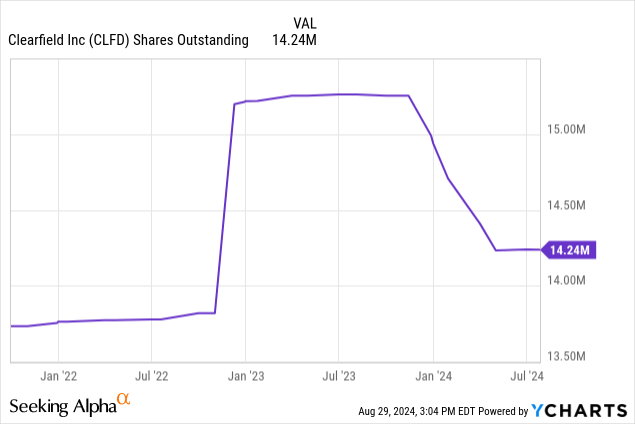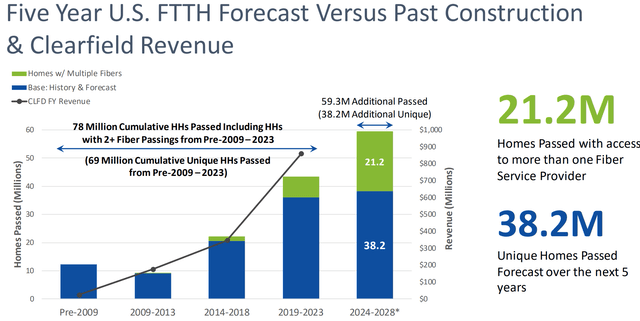John M Lund Photography Inc
I covered Clearfield (NASDAQ:CLFD) almost a year ago with a Buy rating when the stock was trading close to 3-year lows and had dropped more than 80% from all-time highs. The core of my thesis rested on the fact that the market overreacts both on the upside and the downside. Investors who tried to run in front of valuation got burnt, but the over-correction provided a rare opportunity for a swing trade for a company that was adept at managing its financials.
SA
Since then the stock has beaten the S&P and I did take some profits off the table. But I have started to mull things over to see if it was still worth holding the rest of my position.
Quick Recap of my last Clearfield Coverage
What initially grabbed my attention to the stock was the deep over-correction but what made me stay was the scope of its future growth, great financial health, and management of its balance sheet (They issued stock and raised cash at the height of the valuation essentially leveraging the market dislocation. This cash was then gaining interest income!). Additionally, valuation-wise, it was trading close to its book value and quite undervalued compared to its peers. It was also a victim of the market breadth phenomenon and irrespective of quality all small caps were getting crushed. Two important developments after my analysis have resulted in me holding on to part of my position.
Development #1 – Sell High, Buy lower
At its peak valuation in late 2022, the company smartly raised $130M by issuing stock. This move allowed the company to strengthen its balance sheet and reduce debt from acquiring Nestor Cables. The timing was advantageous, allowing the company to raise a substantial amount of capital with minimal dilution. However, the stock price dropped significantly shortly thereafter. Since then, the cash has been earning interest income. From Clearfield’s latest 10-Q –
Net investment income for the nine months ended June 30, 2024, was $5,653,000 compared to $3,328,000 for the comparable quarter for fiscal 2023. The increase in interest income is due to higher interest rates earned and a higher average investment balance in the nine months ended June 30, 2024.
While the cash was earning interest income, the company engaged in another opportunistic play. I had posited in my previous coverage that the smart move would be to buy back their shares, since I believed it was an overcorrection and undervalued. Shortly after, the company announced a buyback back that has only increased in the last two quarters (For the nine months ending on June 30, 2024, the company repurchased $33.3M of the common stock)

Two important things to note here!
- By selling high and buying lower, the company canceled the majority of the dilution it induced when raising capital.
- The capital raised was also earning interest income, which also could have partly gone towards the buyback.
Quite impressed with this financial engineering, which contrasts a lot with some companies that are continuously issuing stock (for capital raise or SBC) and having a simultaneous buyback at all-time highs that has little effect on dilution. Many times when these stocks drop due to deteriorating business, the buybacks are often suspended!
Development #2 – Insider Buy
A well-known truth is that Insider selling could be a lot of noise, but buying indicates confidence in the company and belief in price appreciation.
Insider transactions (Open Insider)
Data from Open Insider for insider activity in Clearfield shows that five insiders have bought the company’s stock so far, with the latest buy coming this month. Overall, it has to be noted that the skin in the game is quite significant in this company as insider ownership is more than 15% and this aligns management incentives with general shareholders (CEO, Board Chairman, COO, a director, and CFO own significant ownership in the company)
Clearfield’s Q3 2024 Results and Outlook
Even though Clearfield’s total sales for Q3 2024 were $48.8M, above the high end of the guidance range (EPS of -$0.04 beats by $0.31, revenue beats by $6.67M) it was still down 20% for the comparable quarter. After the breakneck growth of the early 2020s, growth rates have been normalizing with considerable headwinds in 2023 and 2024 was expected to be a transition year. Gross margins and operating margins have trended up sequentially and still have a way to go before they start making a positive impact on the bottom line. But the outlook is bright as non-government-funded fiber deployments are expanding the addressable market, and within the next decade, around 33% of U.S. homes with fiber access will have the option of choosing from multiple fiber providers.
Overall, the future shows promise for Clearfield. $
100B has been allocated for broadband under the Biden infrastructure package
with more than $10B in subsidies for broadband infrastructure in the next three years.
The Broadband Equity, Access, and Deployment (BEAD) Program is a significant federal initiative designed to expand high-speed internet access across the United States, particularly targeting underserved and unserved communities.
BEAD funds can be used for various projects such as deploying or upgrading Broadband Networks, which includes laying fiber-optic cables and building wireless networks in rural areas.
Additionally, there is also the Enhanced Alternative Connect America Cost Model (Enhanced A-CAM) program which aims to achieve a similar objective with the biggest key difference being lower A-CAM offering lower funds over a longer timeline.
This is what the CEO had to say about the BEAD program and ACAM –
We are seeing a significant increase in quoting activity for our BEAD-compliant products from both existing and new customers. As of earlier this week, 26 states and territories have been approved to move into the award process.
We continue to expect to recognize initial revenue from customer participation in the BEAD program, starting late in calendar 2025, with more significant ramp in activity anticipated in fiscal 2026.
We recently enhanced the company’s manufacturing facilities in Minnesota to accommodate BABA requirements and ensure customers have the products needed to meet their deployment schedules. We expect the majority of our portfolio to be BEAD-compliant by the end of this current fiscal year…
.. Additionally, we are working with the Fiber Broadband Association to lobby the NTIA reduce complexity, and streamline the BEAD award process. While we wait for the ramp in BEAD orders, we are currently receiving orders from service providers eligible for the $18 billion in funds allocated to the Enhanced Alternative Connect America Cost Model, or ACAM, this program, as well as private funding sources.
Clearfield’s valuation is a work in progress
Tough to value a company in its transition year, and most of the bullish outlook is geared a year out. Headwinds faced by the company mean bottom-line valuation metrics are not useful, and we will have to rely on their sales and the strength of their balance sheet. In my initial analysis, I had argued that this was a value play but this is no longer the case.
Currently, Clearfield company is trading at 2.5x EV/Sales and looks favorable in its sector. Again, this ratio was possible mainly because the company was able to raise cash at an opportune time, whereas many other companies in the sector may not have been as fortunate. The same applies to book value trading at 1.9x against the sector median of 3.2x.
Risks and Concluding Thoughts
I would strongly say that investing in this company would not be for someone with a short timeframe. With the business still recovering, its bottom line is nothing to write home about. This means that over a 0–12 month time frame, any rise in stock price may have more to do with technicals rather than fundamentals. Its valuation also reflects the current challenges faced by it, and I don’t think there is any upside in that argument either.
The first time around, my bull case rested on the deep overcorrection in the stock eventually recovering and the undervaluation of the company.
Now, the bull case rests on my confidence in the management’s ability to outperform their peers during challenging periods, as demonstrated by their effective balance sheet management. Additionally, as a leader in the industry, the company is well-positioned to benefit significantly from government programs like BEAD and ACAM, but the true impact will be seen at least a year out from here. I believe a Hold rating would be in line with the company’s prospects.


